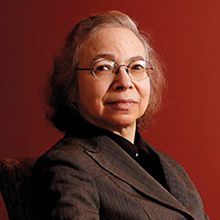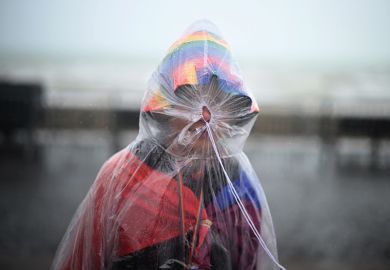The brakes of a tram fail suddenly. Ahead are five people working on the tracks. The tram will ineluctably kill them unless the driver steers the brakeless tram on to a branch line, where the lone person on the tracks would be killed instead. What should the driver do? Offered this imaginary predicament, most of us opt for diversion to the branch line. Why then, asks philosopher Philippa Foot, who devised this thought experiment in 1967, do we see so differently the case of a surgeon killing someone so as to distribute that person’s organs between five people who would otherwise die? The outcome in both cases is the same – five lives are saved at the cost of one – yet somehow we baulk at the thought of the high-handed surgeon.
Since 1967, Foot’s tram has changed into a trolleybus (America), then into a train. It has careered off into numerous varying scenarios, acquiring all sorts of extra protagonists along the way, as well as bombs, tractors, looped lines, lazy Susan swivel-levers and other paraphernalia. Judith Jarvis Thomson added the new dimension of what a bystander to the scene would be justified in doing to pre-empt the trolley’s inexorable progress towards the five workers: push a fat man off a bridge on to the trolley tracks, for instance. In the almost half a century since Foot’s famous paper, her thought experiment has been elevated into a specialised area of ethics, jokingly called “trolleyology”.
The Trolley Problem Mysteries consists of the 2013 Tanner Lectures on Human Values – given at the University of California, Berkeley by Frances Kamm, a trolley aficionado – and some of the responses to them. Thought experiments, as Kamm reminds us, are “constructed, like scientific experiments, to distinguish among and test theories and principles”. How right it sounds, both morally and rationally, to say that an action is good to the extent that it produces the greatest happiness (and least suffering) in the greatest number. But applying this general (utilitarian) principle to particular, if hypothetical, situations can highlight dubious factors in it that grate against our intuitions, inducing us to question, revise, even discard, consequentialist theories. Is an action’s outcome the exclusive determinant of that action’s rightness or wrongness?
Kamm is a self-styled non-consequentialist, but she has always agreed with consequentialists that what crucially distinguishes the Fat Man Case from the Driver’s Two Options is not the distinction between killing and letting die, because these are often tantamount to the same thing. Nor, she says, would Thomson’s distinction between redirecting an already-existent threat and creating a new one be of any help: surely driver or bystander could sometimes be justified in creating a threat subsequent to the original brake failure, for instance if swivelling a turntable would save the five people on top of it only because it deliberately causes a rockslide to push a passerby on to the tracks. With characteristic ingenuity, Kamm argues that what explains why our intuitions are affronted in some cases but amenable in “structurally similar” ones is “how we bring about the harm that will have a necessary causal role in saving the five”. According to her “principle of permissible harm”, when the driver saves the five by deflecting the trolley towards the one, “the five being saved is simply the trolley’s moving away”; the one being killed is that movement’s “noncausal flip-side”. With the Driver’s Two Options, one person is “substituted” for the five, which is permissible; but in the Fat Man Case, he is “subordinated” to them, which is not.
Does Kamm’s “principle of permissible harm” successfully distinguish permissible from impermissible killing? Thomas Hurka’s counterexample, about how we appraise collateral damage in a just war, suggests not. Kamm’s forte, however, lies less in her purported “solutions” than in the illuminating new perspectives and puzzles she opens up. Enlisting Thomson’s example of a bystander who could, instead of letting the trolley plough into the five people, redirect it either towards another person or towards himself, Kamm argues that this “third option” produces “an interaction effect”. “Making a choice between oneself and another might necessitate treating the other as one treats oneself, even if one need not treat him as one would treat oneself when there is no such choice to be made.” So not only is it important what your intentions are but what they would have been in a different situation. And what about the viewpoint of the putatively sacrificed innocent? Kamm asks. If he can be said to have objectively valid grounds for complaint, this introduces yet further implications for the trolley problem. (Thankfully, Kamm doesn’t enumerate them.)
“Whoa, whoa!” you might want to shout, less at the looming trolley than at its infinitely permutating travels. What are all these permutations actually supposed to test? How useful are any of them as tuning forks for a moral principle? One of the features of real-life moral dilemmas is that you cannot be sure of the outcome of what you do, whether the fat man will successfully – if we can put it that way – block the track, whether the rocks you dislodge will have the precisely desired effect, or whether (as in yet another proffered example) your back will be broken or you will be killed instead. That these very uncertainties would affect your decision, perhaps weight it towards letting things take their course and not attempting to interfere, is surely a crucial factor in the problem’s overall evaluation.
Maybe such physical and psychological contingencies are irrelevant; maybe we are just testing what it would be objectively rational and moral to do. But they must be relevant to questions of moral blame. In setting moral rules and assessing the morality of actions, we need to make some allowance for our ineluctable instincts of panic and of self-preservation, for our incapacity to be wholly rational or to properly surmount self-concern. How superhuman does morality require us to be?
You could take the opposite tack and query the importance ascribed to intuitions. They can, after all, be considered as simply the flotsam of evolution, contingent and therefore arbitrary, not suitable criteria for our moral principles at all. Or they can be seen as the unrecognised hangover of religious notions that there is a sacrosanct divine plan and that we jeopardise our freely willing souls if we interfere with it. Should we be working out not what intuitions we in fact have but rather what intuitions we ought to have?
Shelly Kagan, in his response, objects that Kamm presupposes both that our intuitions are all alike and that they would, if properly tapped, ultimately yield a single principle. Why assume that our intuitions precede and inspire our principles, he asks? Isn’t it our (non-homogeneous) principles that generate our (still more heterogeneous) intuitions? Kamm happens to have a non-consequentialist principle; Kagan’s own is consequentialist; their intuitions are systematically discrepant.
But then, where do the principles come from? It is pointless to answer “from our respective cultures, upbringings and neural impulses”, for these are arbitrarily various. On what grounds, when trying to be ideally rational and impartial, should we adjudicate between the principles such factors yield? Obviously the principles don’t come from God, but our religious legacy may be less dispensable than we think. Would we be the evolutionary kingpins that we are without our sense of located agency and of inhabiting a narrative in which immediate suffering (our own and other people’s) constitutes an emergency, whereas distant suffering is hardly salient? Will we ever really be able to regard ourselves as neutral pipelines for objective, impersonal outcomes?
How far, if at all, should individual human rights override considerations of general human well-being? Human rights should prevail, asserts Thomson in a rather tetchy response to Kamm. Thomson herself has recently become more extreme in her non-consequentialism. She now declares it impermissible even to divert the trolley away from five people towards one. Thus, she insists, “the so-called trolley problem is a non-problem”. Never! Thanks to subtle, brilliant, agonised non-consequentialists such as Frances Kamm, the trolley problem will surely run and run.
Jane O’Grady is visiting lecturer in philosophy of psychology, City University London, and co-founder, London School of Philosophy.
The Trolley Problem Mysteries
By F. M. Kamm
Edited by Eric Rakowski, with commentaries by Judith Jarvis Thomson, Thomas Hurka and Shelly Kagan
Oxford University Press, 272pp, £19.99
ISBN 9780190247157
Published 21 January 2016
The author
 F. M. Kamm is Lucius Littauer profess of philosophy and public policy, Harvard Kennedy School, and professor of philosophy, Harvard University. She divides her time between residences in Cambridge, Massachusetts and New York (“where cats have come to visit”).
F. M. Kamm is Lucius Littauer profess of philosophy and public policy, Harvard Kennedy School, and professor of philosophy, Harvard University. She divides her time between residences in Cambridge, Massachusetts and New York (“where cats have come to visit”).
She was born and raised in Queens, New York. “My parents were designers and artists who instilled in me a love of art and education. My mother in particular encouraged me to speak up,” she recalls. Living in New York, she adds, “instilled drive. My father’s death when I was in high school prompted philosophical interests.”
As a child, she was studious, “influenced by my parents’ intellectual interests. In graduate school, Robert Nozick’s courses were eye openers and I work on many topics I discovered in his seminar. He encouraged me at a crucial time and also led me to the practice of meditation. After invaluable thesis supervision by Barbara Herman, unexpectedly, my uncle’s presence led me to apply for a job at New York University, where I had remarkable colleagues such as Thomas Nagel, Derek Parfit and Ronald Dworkin, and enjoyed visits by other notables.”
She took her undergraduate degree at Barnard College, with a major in philosophy. “I was determined, and participated actively in class, but was rather solitary until I participated in the feminist movement on campus in my senior year.”
Kamm has served as an ethics consultant to the World Health Organization. She recalls: “The WHO was working on measures of population health that included quality assessments of lives. This was controversial, so a group of philosophers was asked to consult. I contributed an essay on allocating scarce resources to a WHO book. I also published a lengthy paper about quality assessment of disabilities and its bearing on allocating scarce medical resources. The group met in different locations to review each other’s work and discussions across disciplines was rigorous and helpful.”
For some years, Kamm has been writing and speaking about abortion. Although abortion rights have been enshrined in law in many countries, including the US, it remains a contentious issue. Does she expect this to change in her lifetime? “I only think this state of affairs could be helped to change for the better if people’s arguments for one position or another were subjected to careful reasoning that was publicised,” she replies. “When I teach about abortion in an ethics class, students are typically surprised that one can reason about the issue. It is disappointing that they were not exposed to critical thinking about this and other controversial topics earlier, in school and in public venues.”
With regard to the trolley problem and its use in introducing non-philosophers to some of the issues that philosophers consider, Kamm says, “I think much of ethics is intricate – Intricate Ethics is the title of one of my book – and most people actually are sensitive to and employ many distinctions. It is bringing this to consciousness and theorising about it that is unusual, and that the trolley problem helps them do.” She adds: “I have introduced the problem to many students and colleagues who are not philosophers, who then can’t stop thinking about it.”
Asked what issues in bioethics – new or old – are currently of greatest interest to her, Kamm says, “At the moment, I am to write about death and dying again.”
Karen Shook
POSTSCRIPT:
Print headline: A test track for moral reasoning
Register to continue
Why register?
- Registration is free and only takes a moment
- Once registered, you can read 3 articles a month
- Sign up for our newsletter
Subscribe
Or subscribe for unlimited access to:
- Unlimited access to news, views, insights & reviews
- Digital editions
- Digital access to THE’s university and college rankings analysis
Already registered or a current subscriber? Login




